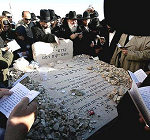On 26 August, Nariman House, the Colaba-based, India headquarters of Chabad Lubavitch, the worldwide orthodox Jewish movement, was re-dedicated as Chabad Centre. The building was left ravaged after it was targeted during the 26/11 Mumbai terror attack nearly six years ago. The Chabad Lubavitch has a presence in over 3000 cities around the world, and the attack and murder of Rabbi Gavriel Holtzberg, wife Rivka, and their four guests, added a global dimension to the incident.
After a soulful rendition of El Male Rachamim (Jewish prayer for the souls of the dead), followed by a lively benediction for the re-opened centre, came the announcement that the Chabad Lubavitch would spend $2.5 million towards building a Nariman House Museum and Memorial.
The idea is unique to Mumbai even though the city has lost hundreds of innocent citizens in a spate of deadly terror attacks. The concept is more familiar to the Indian armed forces, whose museum-memorials are a treasure trove of history, memories and eventual healing for those who have lost loved ones in action.
The tragedy of 26/11 and the outpouring of grief that the city witnessed in its aftermath have made the once obscure Nariman House and the Chabad Lubavitch an indelible part of Mumbai’s history.
“This is the first museum in India dedicated to the 26/11 siege and the only memorial dedicated to all the victims”, said Rabbi Israel Kozlovsky, present director of the Mumbai Chabad House at the ceremony.
The museum-memorial will be designed by Ralph Appelbaum Associates, the world’s largest museum exhibition design firm based in New York. The firm has also designed the United States Holocaust Memorial Museum, based in Washington D.C., which is dedicated to the six million Jews who lost their lives in Nazi labour camps during World War II.
The highlight of the Mumbai site will be a wall set up on the outdoor roof deck of Nariman House, which will be specially designed to represent the climactic moments of the attack. Called Memorial to the Innocent, it will list the names of all the victims alphabetically, with a special prism highlighting each name.
The choice of the roof deck is especially fitting as it was here that Indian commandos descended from helicopters in the final hours. From the deck one also gets a view of all the other sites that were targeted, like the Taj Mahal Palace Hotel and Tower, Oberoi Hotel, Chhatrapati Shivaji Terminus, and Cama and Albless Hospital.
The museum-memorial will highlight the seven virtues of morality common to all religions, as well as the daily rituals of the Jewish community. The fifth floor where the late rabbi and his family lived, will be recreated like a traditional Jewish home with symbols like the mezuzah (hollow cylinder holding a small prayer scroll usually fixed to the main door), and a kosher kitchen, which have a separate wash basin where dishes used for cooking meat are kept.
The touches become even more poignant when one remembers how Mumbai was once home to a vibrant Jewish community – comprising of West Asian Baghdadi Jews, and local Bene-Israelis from the mainland Konkan littoral for a good 300 years. The presence has significantly reduced due to large scale immigration to Israel and the West.
Until the middle of the 20th century, BEST trams and buses would issue special passes to Jews so they could travel in the Sabbath period without having to exchange money. The Sabbath period extends for 24 hours, starting from Friday sunset. Government colleges in the city would declare a holiday on Yom Kippur, the Day of Atonement. This shows just how enormous their influence was. Institutions built by the community, especially the wealthy and orthodox Sassoon family, are still intrinsic to city life, but awareness is virtually non-existent.
This site will play an important role – it will memorialise the tragedy as well as educate visitors about Jewish living – something that was so present and evident in our city just 50 years ago.
Sifra Lentin is a Mumbai-based writer and historian, and the Mumbai History Fellow at Gateway House: Indian Council on Global Relations.
This blog was exclusively written for Gateway House: Indian Council on Global Relations. You can read more exclusive content here.
For interview requests with the author, or for permission to republish, please contact outreach@gatewayhouse.in.
© Copyright 2014 Gateway House: Indian Council on Global Relations. All rights reserved. Any unauthorized copying or reproduction is strictly prohibited


